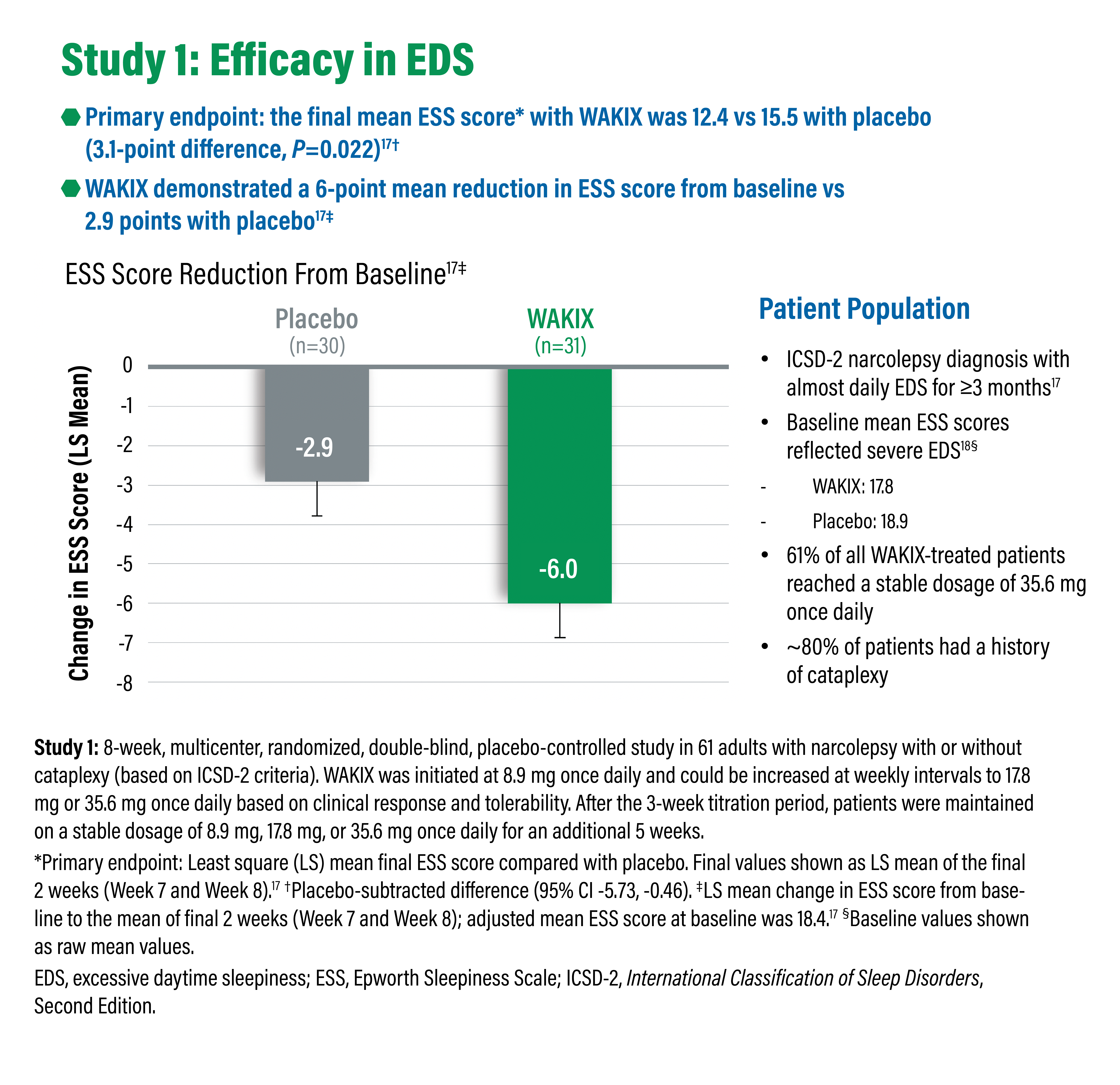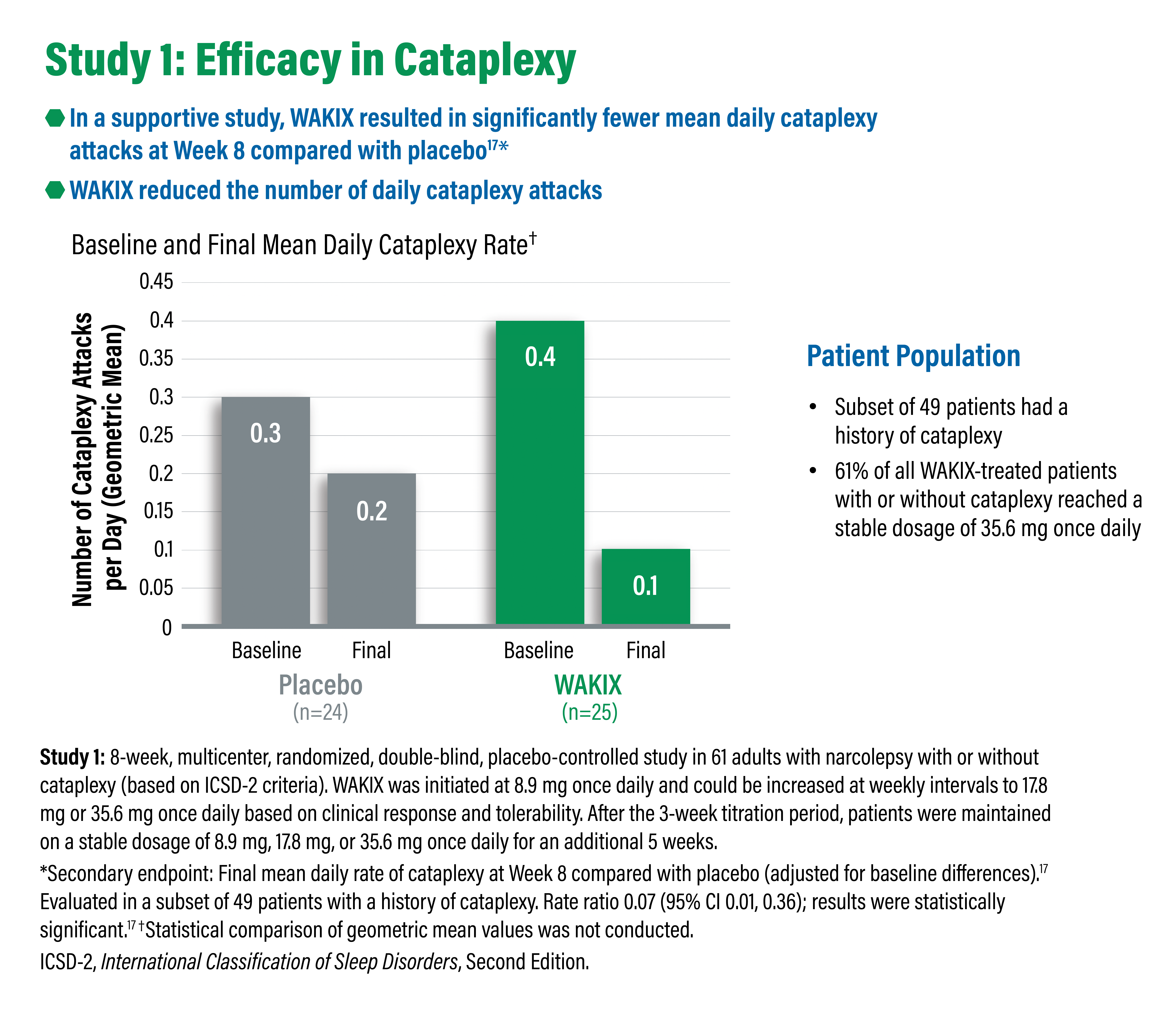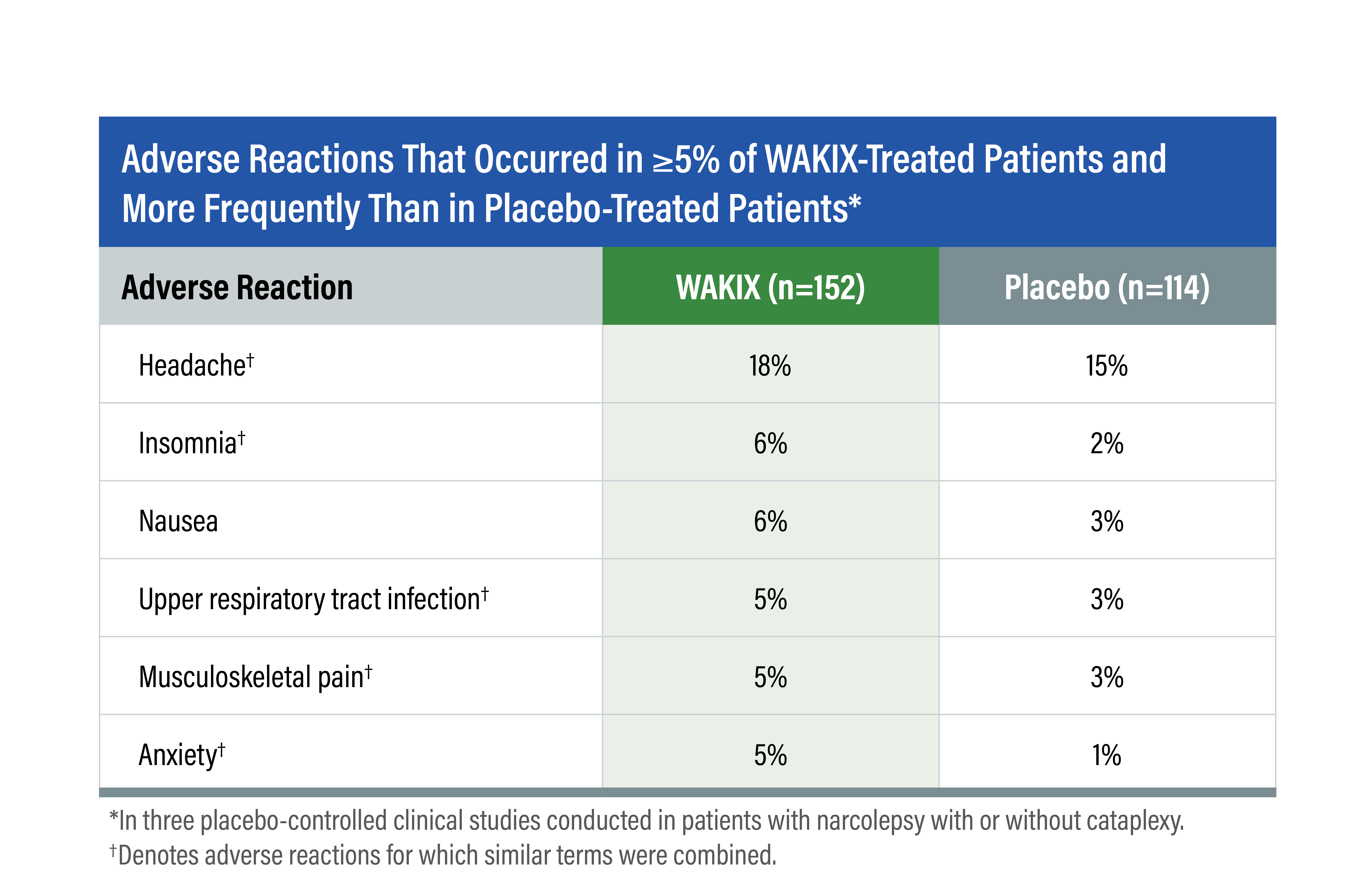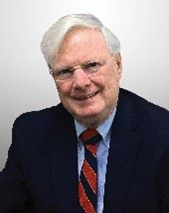News
Article
Case Study and Overview of WAKIX® (pitolisant) Tablets in the Treatment of Excessive Daytime Sleepiness and/or Cataplexy in Adults with Narcolepsy
Author(s):
Sponsored by Harmony Biosciences.
Narcolepsy is a rare, chronic, debilitating neurological disorder of sleep-wake state instability that affects approximately 165,000 individuals in the United States.1-3 The cause of narcolepsy in most patients is the loss of hypocretin (orexin) neurons in the brain that leads to reduced or inconsistent activation of histamine and other wake-promoting neurons, resulting in sleep-wake state instability.1,3 The hallmark narcolepsy symptom is excessive daytime sleepiness (EDS), which is defined as daily episodes of an irrepressible need to sleep or unintended lapses into sleep.4 The reduced or inconsistent activation of histamine and other wake-promoting neurons is the cause of EDS.3,5 EDS involves an overwhelming need to sleep throughout the day and lapses into sleep—typically during sedentary activities but sometimes may occur during active activities.4,5 Lapses into sleep may occur several times each day, although episode frequency and duration can vary considerably across different individuals and environments.5 Additionally, EDS can manifest in ways that are not obvious, such as lapses in vigilance or concentration.4,5 Identification of EDS can be a challenge.4
How many individuals in the US are estimated to have narcolepsy?1,2
The second-most common symptom of narcolepsy (experienced by approximately 70% of patients)6-8 is cataplexy, which is a sudden, brief weakness and loss of muscle control while a person is awake.4 Narcolepsy with cataplexy (also referred to as narcolepsy type 1) is often caused by the selective loss of hypocretin neurons.4 In narcolepsy without cataplexy (also referred to as narcolepsy type 2), the underlying cause is often not known.4 Often triggered by strong emotions, or certain situations, a cataplectic episode is most commonly minor, such as droopy eyelids.4,9 Less frequently, it could be more severe, such as total body collapse.9 The first episode may not appear for years following EDS onset, and episode frequency can range from several attacks each day to only a few attacks throughout a year.5,10
True or False:
In most cases, narcolepsy is caused by the loss of hypocretin neurons, which leads to reduced or inconsistent activation of histamine and other wake-promoting neurons.1,3
Clinicians and patients may be challenged with recognizing the symptoms of narcolepsy.9,10 In addition, there may be a misdiagnosis of another disorder and/or a delay up to 15 years for accurate narcolepsy diagnosis.9 This suggests the importance of healthcare practitioners performing a thorough clinical interview with patients during symptom evaluation.
Which of the following is NOT a common characteristic of type 1 narcolepsy?4
With consideration toward the associated high healthcare utilization and costs, as well as the substantial burden of narcolepsy on patients' physical and psychosocial wellbeing, it is imperative to educate the public and clinicians on the standard clinical characteristics of narcolepsy to improve early diagnosis.9 Diagnostic tests for narcolepsy should be conducted whenever narcolepsy features are present.9 The International Classification of Sleep Disorders – Third Edition (ICSD-3) diagnostic criteria for narcolepsy includes a mean sleep latency of ≤ 8 minutes on the Multiple Sleep Latency Test and the presence of two or more sleep-onset rapid eye movement periods, one of which can be on the preceding night’s polysomnogram.4
True or False:
Cataplexy is often triggered by strong emotions, such as laughter or anger.9
For those diagnosed with narcolepsy, identifying appropriate interventions for the treatment of EDS and/or cataplexy is important.
WAKIX® (pitolisant) is a histamine 3 (H3) receptor antagonist/inverse agonist indicated for the treatment of EDS or cataplexy in adult patients with narcolepsy. It is the first and only FDA-approved non-scheduled therapeutic option for this patient group. In this article, we will review the safety and efficacy data for WAKIX from clinical studies, as well as a clinical case study of a patient with type 1 narcolepsy who started treatment with WAKIX.
OVERVIEW OF WAKIX
The mechanism of action of WAKIX in EDS or cataplexy in adult patients with narcolepsy is unclear; however, its efficacy could be mediated through its activity as an antagonist/inverse agonist at H3 receptors, which results in increased levels of histamine in the brain.11,12 Originating in the hypothalamus, hypocretin and histamine neurons play complementary roles in promoting and stabilizing wakefulness by activating the cortex and other wake-promoting neurons and inhibiting both non-REM and REM sleep-promoting neurons.13-16 WAKIX is the first and only histaminergic treatment for EDS or cataplexy in narcolepsy. WAKIX is not a stimulant and not a controlled substance.
WAKIX offers once-daily morning oral dosing and has a recommended dosage range of 17.8 mg to 35.6 mg daily. WAKIX is initiated 8.9 mg once daily and is titrated at weekly intervals. The maximum recommended dosage of WAKIX is 35.6 mg once daily.
Dose modifications are recommended for patients with moderate hepatic impairment, moderate or severe renal impairment, concomitant use of strong CYP2D6 inhibitors or strong CYP3A4 inducers, and for those known to be poor CYP2D6 metabolizers. WAKIX is contraindicated in patients with severe hepatic impairment and not recommended in patients with end-stage renal disease. Read more Important Safety Information.
In a clinical pharmacokinetic study that evaluated concomitant use of WAKIX with modafinil or sodium oxybate, WAKIX had no effect on the pharmacokinetics (PK) of either modafinil or sodium oxybate and these agents had no clinically relevant effect on the PK of WAKIX. It also bears mentioning that no clinically significant differences in the PK profile of WAKIX were observed following administration with a high-fat meal.
Efficacy of WAKIX In Clinical Trials
Excessive Daytime Sleepiness
The efficacy of WAKIX for the treatment of EDS in adults with narcolepsy was evaluated in two multicenter, randomized, double-blind, placebo-controlled trials. Patients ≥18 years of age who met the International Classification of Sleep Disorders (ICSD-2) criteria for narcolepsy (with or without cataplexy) and who had an Epworth Sleepiness Scale (ESS) score ≥14 were eligible to enroll in the studies. In Study 1, 31 patients were randomized to WAKIX and 30 were randomized to placebo. The dose of WAKIX was initiated at 8.9 mg once daily, which could be adjusted at weekly intervals to 17.8 mg or 35.6 mg once daily based on clinical response and tolerability. After the 3-week titration phase, patients were maintained on a stable dosage for an additional 5 weeks. Evaluation of the primary endpoint [final ESS score compared with placebo evaluated as the least-squares (LS) mean of Week 7 and Week 8] showed that WAKIX (12.4) was superior to placebo (15.5; 3.1-point placebo-subtracted difference, P=0.022).17 Of the patients receiving WAKIX, 61% reached a stable dosage of 35.6 mg once daily.

In Study 2, 66 patients were randomized to WAKIX and 32 were randomized to placebo. WAKIX was started at 4.45 mg once daily and was adjusted to 8.9 mg or 17.8 mg once daily at weekly intervals based on clinical response and tolerability. After the 3-week titration phase, patients were maintained on a stable dosage for an additional 5 weeks. Evaluation of the primary endpoint at week 8 showed that WAKIX achieved a lower LS mean final ESS score (13.3) than did placebo (15.5; 2.2-point placebo-subtracted difference, P = 0.03). 76% of patients in the WAKIX group reached a stable dosage of 17.8 mg once daily.

Cataplexy
The efficacy of WAKIX for the treatment of cataplexy in adult patients with narcolepsy was evaluated in two multicenter, randomized, double-blind, placebo-controlled studies. For Study 3, patients ≥18 years of age who met the ICSD-2 criteria for narcolepsy with cataplexy with at least 3 cataplexy attacks per week and an ESS score of ≥12 were eligible to enroll. In this study, 54 patients were randomized to WAKIX and 51 were randomized to placebo. WAKIX was initiated at 4.45 mg once daily for the first week, increased to 8.9 mg once daily for the second week, and could remain the same or be decreased or increased at the next two weekly intervals to a maximum of 35.6 mg once daily based on clinical response and tolerability. After the 3-week titration period, patients were maintained on a stable dosage of 4.45 mg, 8.9 mg, 17.8 mg, or 35.6 mg once daily for an additional 4 weeks. 65% of patients reached a stable dosage of 35.6 mg once daily. Results demonstrated that those treated with WAKIX experienced greater improvement on the primary endpoint, with approximately half the number of mean weekly cataplexy attacks during the 4-week stable dosing period compared with placebo (rate ratio 0.51; results were statistically significant). Additionally, the final mean weekly cataplexy rate during the 4-week stable dosing period in those treated with WAKIX was 2.3, compared with 9.1 at baseline. Those in the placebo group had a final weekly cataplexy rate of 4.5, compared with 7.3 at baseline.

Supportive findings were shown in a subset of 49 patients with a history of cataplexy in Study 1, in which WAKIX resulted in significant improvement on the secondary endpoint, the final mean daily rate of cataplexy at week 8 compared with placebo.17

A post-hoc analysis of patients pooled from Study 1 and Study 3 evaluated the effects of WAKIX and placebo in patients with severe EDS or cataplexy at baseline19:
- Severe EDS was defined as an ESS baseline score ≥16 at baseline.
- Severe cataplexy was defined as ≥15 cataplexy attacks per week at baseline.
Among patients with severe EDS receiving WAKIX (n = 60), the mean ESS score was 19.0 at baseline and the least squares (LS) mean ESS score was 13.1 at the end of treatment.17,19 Patients receiving placebo (n = 58), had a mean ESS score of 19.4 at baseline and a LS mean score of 16.9 at the end of treatment. The analysis found a 6.1-point LS mean reduction in ESS score from baseline for patients receiving WAKIX and a 2.3-point reduction in patients receiving placebo.19 In patients with severe cataplexy receiving WAKIX (n = 20), the mean number of cataplexy attacks per week was 23.9 at baseline and 9.4 during the stable-dose treatment period. For patients receiving placebo (n = 11), the mean number of cataplexy attacks per week was 23.1 at baseline and 23.0 during the stable-dose treatment period. The analysis found a LS mean reduction of 14.5 cataplexy attacks per week from baseline to stable dose period for the WAKIX group and 0.1 for the placebo group. Limitations of this analysis include that statistical comparison of the treatment groups was not prespecified and the small sample size of patients with severe cataplexy.
Safety of WAKIX In Clinical Trials
In the placebo-controlled clinical studies conducted in patients with narcolepsy with or without cataplexy, the most common adverse reactions (occurring in ≥5% of patients and at least twice the rate of placebo) with the use of WAKIX were insomnia (6% vs 2%), nausea (6% vs 3%), and anxiety (5% vs 1%).

Additional adverse reactions occurring in ≥2% of WAKIX-treated patients and more frequently than in placebo-treated patients* were heart rate increased,† hallucinations,† irritability, abdominal pain,† sleep disturbance,† decreased appetite, cataplexy, dry mouth, and rash†.
In narcolepsy clinical studies in which WAKIX was directly compared with placebo, the incidence of patients who discontinued because of an adverse event was similar between the WAKIX and placebo groups (3.9% [n=6/152] vs 3.5% [n=4/114], respectively). To learn more about the safety of WAKIX, please see the Important Safety Information below.
CASE REVIEW AND ANALYSIS: TREATMENT AND OUTCOME (ADAPTED FROM A REAL-WORLD WAKIX PATIENT CASE)
Now that we have reviewed the clinical data for WAKIX, the following case review adapted from a real-world patient case may help to explain the use of this agent. The individual for this case review is a 24-year-old female with a diagnosis of narcolepsy. She was diagnosed with type 2 narcolepsy 2 years ago, at which time she reported symptoms of EDS and had an ESS score of 22. Now, her ESS score is 18. Her EDS, which she described in her most-recent provider visit as “constant fatigue,” significantly interferes with daily activities, often causing her to leave class to splash water on her face to stay awake. Subsequent questioning in her most-recent visit revealed she experiences a feeling like her face is melting, as well as a tingling in her knees, during excitement. This indicated the onset of cataplexy. Thus, she likely has type 1 narcolepsy and may benefit from WAKIX.
Given the presence of ongoing symptoms despite current treatment at maximum tolerated doses, WAKIX was discussed with patient and added to treatment. WAKIX was added to the regimen for ongoing EDS and cataplexy, initiated at a dosage of 8.9 mg once daily and titrated weekly to the maximum recommended dosage of 35.6 mg once daily by week 3. After a few weeks at the 35.6-mg dose, her symptoms of EDS were improved, and she had an ESS score of 12. Additionally, cataplexy attacks were less frequent.
Clinical Insights Regarding the Use of WAKIX
When we consider the course of this case review, one of the most notable aspects is that the patient was initially diagnosed with type 2 narcolepsy but later experienced symptoms of cataplexy. Importantly, cataplexy may not be present when individuals first develop excessive daytime sleepiness.5 Therefore, it is important to continue to re-inquire about cataplexy along a treatment journey and in subsequent patient visits.
As more details about the individual’s ongoing EDS and cataplexy came into focus, it was clear that she needed something more than she was receiving in her current treatment regimen. The next most logical step was to consider a medication from a different pharmacologic class. Targeting the histaminergic system, WAKIX offered this option for adding to her existing treatment regimen for narcolepsy.
WAKIX may warrant consideration as a monotherapy, as well. For example, WAKIX is a non-stimulant and non-scheduled medication. Lack of abuse potential for WAKIX has been demonstrated in a human abuse potential study. The study was a randomized, double blind crossover study in 38 participants. The measures of human abuse potential included Drug Liking, Take Drug Again, Good Drug Effects, Overall Drug Liking and High. WAKIX demonstrated an abuse potential profile similar to placebo, with no signals from any experimental measures suggestive of abuse and was shown to have significantly lower abuse potential compared with the active control, a schedule IV stimulant.20 Additionally, WAKIX is taken once daily in the morning, which I have found can be a practical benefit for patients.
When treating individuals with narcolepsy, setting patient expectations is very important. Symptoms may improve at different times or rates when taking WAKIX; it may take up to 8 weeks for some patients to achieve a clinical response. WAKIX should be taken once daily in the morning upon wakening and should be individually titrated to the effective dosage. Follow-up appointments and close contact between clinicians and patients for shared decision-making may be necessary.
TAKE-HOME POINTS AND CONCLUSIONS
WAKIX is the first and only histaminergic treatment for EDS or cataplexy in narcolepsy. In addition to its established safety and tolerability profile in clinical studies, WAKIX has been demonstrated to reduce EDS and frequency of cataplexy attacks vs. placebo. WAKIX had no clinically important PK interactions with modafinil or sodium oxybate. It is a non-scheduled drug, which may be important if potential for abuse is a concern. WAKIX is a non-stimulant and also offers convenient once-daily dosing. Given the practical benefits and demonstrated clinical profile, WAKIX warrants consideration for the treatment of EDS or cataplexy in adult patients with narcolepsy.
INDICATIONS AND USAGE
- WAKIX is indicated for the treatment of excessive daytime sleepiness (EDS) or cataplexy in adult patients with narcolepsy.
IMPORTANT SAFETY INFORMATION
Contraindications
- WAKIX is contraindicated in patients with known hypersensitivity to pitolisant or any component of the formulation. Anaphylaxis has been reported. WAKIX is also contraindicated in patients with severe hepatic impairment.
Warnings and Precautions
- WAKIX prolongs the QT interval; avoid use of WAKIX in patients with known QT prolongation or in combination with other drugs known to prolong the QT interval. Avoid use in patients with a history of cardiac arrhythmias, as well as other circumstances that may increase the risk of the occurrence of torsade de pointes or sudden death, including symptomatic bradycardia, hypokalemia or hypomagnesemia, and the presence of congenital prolongation of the QT interval.
- The risk of QT prolongation may be greater in patients with hepatic or renal impairment due to higher concentrations of pitolisant; monitor these patients for increased QTc. Dosage modification is recommended in patients with moderate hepatic impairment and moderate or severe renal impairment (see full prescribing information). WAKIX is not recommended in patients with end-stage renal disease (ESRD).
Adverse Reactions
- In the placebo-controlled clinical trials conducted in patients with narcolepsy with or without cataplexy, the most common adverse reactions (≥5% and at least twice placebo) for WAKIX were insomnia (6%), nausea (6%), and anxiety (5%). Other adverse reactions that occurred at ≥2% and more frequently than in patients treated with placebo included headache, upper respiratory tract infection, musculoskeletal pain, heart rate increased, hallucinations, irritability, abdominal pain, sleep disturbance, decreased appetite, cataplexy, dry mouth, and rash.
Drug Interactions
- Concomitant administration of WAKIX with strong CYP2D6 inhibitors increases pitolisant exposure by 2.2-fold. Reduce the dose of WAKIX by half.
- Concomitant use of WAKIX with strong CYP3A4 inducers decreases exposure of pitolisant by 50%. Dosage adjustments may be required (see full prescribing information).
- H1 receptor antagonists that cross the blood-brain barrier may reduce the effectiveness of WAKIX. Patients should avoid centrally acting H1 receptor antagonists.
- WAKIX is a borderline/weak inducer of CYP3A4. Therefore, reduced effectiveness of sensitive CYP3A4 substrates may occur when used concomitantly with WAKIX. The effectiveness of hormonal contraceptives may be reduced when used with WAKIX and effectiveness may be reduced for 21 days after discontinuation of therapy.
Use in Specific Populations
- WAKIX may reduce the effectiveness of hormonal contraceptives. Patients using hormonal contraception should be advised to use an alternative non-hormonal contraceptive method during treatment with WAKIX and for at least 21 days after discontinuing treatment.
- There is a pregnancy exposure registry that monitors pregnancy outcomes in women who are exposed to WAKIX during pregnancy. Patients should be encouraged to enroll in the WAKIX pregnancy registry if they become pregnant. To enroll or obtain information from the registry, patients can call 1-800-833-7460.
- The safety and effectiveness of WAKIX have not been established in patients less than 18 years of age.
- WAKIX is extensively metabolized by the liver. WAKIX is contraindicated in patients with severe hepatic impairment. Dosage adjustment is required in patients with moderate hepatic impairment.
- WAKIX is not recommended in patients with end-stage renal disease. Dosage adjustment of WAKIX is recommended in patients with moderate or severe renal impairment.
- Dosage reduction is recommended in patients known to be poor CYP2D6 metabolizers; these patients have higher concentrations of WAKIX than normal CYP2D6 metabolizers.
To report suspected adverse reactions, contact Harmony Biosciences at 1-800-833-7460 or FDA at 1-800-FDA-1088 or www.fda.gov/medwatch.
Please see accompanying Full Prescribing Information.
For more information about WAKIX, please visit WAKIXhcp.com.
WAKIX is a registered trademark of Bioprojet Europe, Ltd.
Ⓒ 2023 Harmony Biosciences. All rights reserved.
US-WAK-2200148/Jan 2023

Michael J. Thorpy, MD, is Director of the Sleep-Wake Disorders Center at Montefiore Medical Center and Professor of Neurology at Albert Einstein College of Medicine.
References
1. Scammell TE. Narcolepsy. N Engl J Med. 2015;373:2654-2662. doi: 10.1056/NEJMra1500587
2. United States Census Bureau. Quick Facts, United States. https://www.census.gov/quickfacts/fact/table/US/PST045221. Accessed September 2, 2022.
3. Thorpy MJ, Bogan RK. Update on the pharmacologic management of narcolepsy: mechanisms of action and clinical implications. Sleep Med. 2020;68:97-109. doi: 10.1016/j.sleep.2019.09.001
4. American Academy of Sleep Medicine. International Classification of Sleep Disorders. 3rd ed. Darien, IL: American Academy of Sleep Medicine; 2014.
5. Zhang J, Han F. Sleepiness in narcolepsy. Sleep Med Clin. 2017;12(3):323-330. doi: 10.1016/j.jsmc.2017.03.008
6. Ruoff C, Rye D. The ICSD-3 and DSM-5 guidelines for diagnosing narcolepsy: clinical relevance and practicality. Curr Med Res Opin. 2016;32(10):1611-1622. doi: 10.1080/03007995.2016.1208643
7. Ahmed I, Thorpy M. Clinical features, diagnosis and treatment of narcolepsy. Clin Chest Med. 2010;31(2):371-81. doi: 10.1016/j.ccm.2010.02.014
8. Silber MH, Krahn LE, Olson EJ, Pankratz VS. The epidemiology of narcolepsy in Olmsted County, Minnesota: a population-based study. Sleep. 2002;25(2):197-202. doi: 10.1093/sleep/25.2.197
9. Thorpy M, Morse AM. Reducing the Clinical and socioeconomic burden of narcolepsy by earlier diagnosis and effective treatment. Sleep Med Clin. 2017;12(1):61-71. doi: 10.1016/j.jsmc.2016.10.001
10. Heidbreder, A., Dirks, C. & Ramm, M. Therapy for cataplexy. Curr Treat Options Neurol. 2020; 22:13. doi: 10.1007/s11940-020-0619-511
11. Schwartz J. The histamine H3 receptor: from discovery to clinical trials with pitolisant. Br J Pharmacol. 2011;163(4):713-721. doi: 10.1111/j.1476-5381.2011.01286.x
12. Nieto-Alamilla, G, Marquez-Gomez R, Morales-Figueroa G, Arias-Montano J. The histamine H3 receptor: structure, pharmacology, and function. Mol Pharmacol. 2016;90(5):649-673. doi: 10.1124/mol.116.104752
13. Haas HL, Sergeeva OA, Selbach O. Histamine in the nervous system. Physiol Rev. 2008;88(3):1183-1241. doi: 10.1152/physrev.00043.2007
14. Scammell TE, Jackson AC, Franks NP, et al. Histamine: neural circuits and new medications. Sleep. 2019;42(1). doi: 10.1093/sleep/zsy183
15. Scammell TE, Arrigoni E, Lipton JO. Neural circuitry of wakefulness and sleep. Neuron. 2017;93(4):747-765. doi: 10.1016/j.neuron.2017.01.014
16. Anaclet C, Parmentier R, Ouk K, et al. Orexin/hypocretin and histamine: distinct roles in the control of wakefulness demonstrated using knock-out mouse models. J Neurosci. 2009;29(46):14423-12238. doi: 10.1523/JNEUROSCI.2604-09.2009
17. Data on file. Harmony Biosciences.
18. Johns M. About the ESS. http://epworthsleepinessscale.com/about-the-ess/. Accessed October 6, 2022.
19. Davis CW, Kallweit U, Schwartz JC, Krahn LE, Vaughn B, Thorpy MJ. Efficacy of pitolisant in patients with high burden of narcolepsy symptoms: pooled analysis of short-term, placebo-controlled studies. Sleep Med. 2021;81:210-217. doi: 10.1016/j.sleep.2021.02.037
20. Setnik B, McDonnell M, Mills C, et al. Evaluation of the abuse potential of pitolisant, a selective H3-receptor antagonist/inverse agonist, for the treatment of adult patients with narcolepsy with or without cataplexy. Sleep. 2020;43(4):zsz252. doi: 10.1093/sleep/zsz252